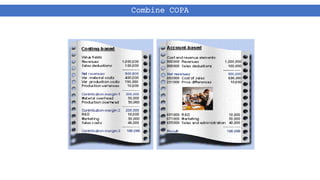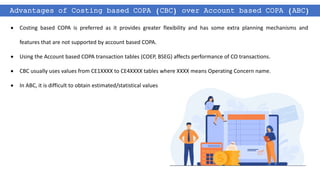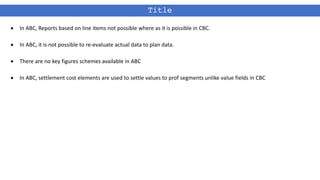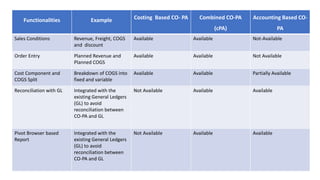SAP CO-PA (Controlling-Profitability Analysis)
- 1. COPA = Controlling – Profitability Analysis
- 2. Introduction • COPA is one of the components of controlling modules of SAP which deals with reporting of profitability across various dimensions. • It stands for controlling-profitability analysis which is commonly referred to as SAP-COPA • It enables you to evaluate your company’s profit or contribution margin by market segment or by strategic business unit (such as a sales organization or profit centre). • Profitability Analysis provides your sales, marketing, product management, and corporate planning departments with information to support internal accounting and decision-making.
- 3. Key reporting dimensions of SAP-COPA ● Customer ( customer wise report) ● Products ( product wise profitability) ● Region ( Region wise profitability- East, North) ● Employee (Sales representative) ● Sales Category (Domestic, Exports)
- 4. Types of COPA Account based COPA Costing based COPA Combine COPA
- 5. Costing based COPA This is the form of profitability analysis in which group costs and revenues are according to the value fields and also based upon the costing based approaches which can be defined by the user. It guarantees that all these fields can be accessed at any time.
- 6. Account based COPA This is the form of profitability analysis in which group costs and revenues are according to the value fields and also based upon the costing based approaches which can be defined by the user. It guarantees that all these fields can be accessed at any time.
- 7. Combine COPA
- 8. Drawbacks of account based COPA 1. Cost component breakdown can be obtained. 2. There is no breakdown of variance categories 3. The tables (COEP, COEJ, COSP, COSS etc.,) used by overhead cost management are used in account based COPA, whereas costing based COPA has its own customized tables.
- 9. Advantages of Costing based COPA (CBC) over Account based COPA (ABC) Costing based COPA is preferred as it provides greater flexibility and has some extra planning mechanisms and features that are not supported by account based COPA. Using the Account based COPA transaction tables (COEP, BSEG) affects performance of CO transactions. CBC usually uses values from CE1XXXX to CE4XXXX tables where XXXX means Operating Concern name. In ABC, it is difficult to obtain estimated/statistical values
- 10. Title In ABC, Reports based on line items not possible where as it is possible in CBC. In ABC, it is not possible to re-evaluate actual data to plan data. There are no key figures schemes available in ABC In ABC, settlement cost elements are used to settle values to prof segments unlike value fields in CBC
- 11. Dataflow in COPA
- 12. Costing based COPA Value fields like group costs and revenue elements are used in costing based COPA; Costing based COPA has Reconciliation issues; In COPA, the incoming sales order data is transferred to SD condition types to analyze anticipated sales for whose delivery has not yet taken place.
- 13. Title 1. Variance analysis is possible in COPA 2. Operating concern tables that are generated, are listed as under: a. CE1xxxx : actual line item table b. CE2xxxx : plan line item table c. CE3xxxx : segment level d. CE4xxxx : segment table 3. Incoming Sales Order data cannot be mapped in account based CO-PA
- 14. What is SAP S/4HANA SAP S/4HANA is an enterprise resource planning (ERP) solution which has built in technologies that includes AI, machine learning, deep learning and other advanced analytics. SAP S/4 HANA has added automation to the existing business processes. At present, SAP HANA is a market leader in providing databases that offer high speeds in real time.
- 15. SAP S/4HANA – COPA modifications
- 16. Flow of actual data The data is transferred and saved by the record types in the costing based CO-PA. The data is transferred and saved by the record types in the costing based CO-PA.
- 17. Title Record type Description B FI –> CO-PA C CO –> CO-PA IO settlement to CO-PA MM Production Variances F SD Billing Data A Incoming Sales Order
- 18. Account based v/s Costing based COPA in S4/HANA • Costing based CO-PA was more advantageous before the arrival of S4 HANA 3rd generation; • Now, most of the capabilities of costing based COPA are added in the account based COPA; • With S4/ HANA, it is recommended to use Account based COPA in S4/ HANA as per out analysis.
- 19. Why Account based COPA is better than Costing based COPA in S4/HANA Account based COPA Costing based COPA Data transfer happens from FI using the Cost & revenue elements Costs to G/L accounts and SD Condition types are mapped using the value fields Costs to G/L accounts and SD Condition types are mapped using the value fields Costs to G/L accounts and SD Condition types are mapped using the value fields Even after S4HANA, the data of the incoming sales order cannot be mapped. The data through SD condition types to analyze anticipated sales of whose delivery period has not yet taken place. Cost component split data can be sent to it; the same was not possible in ECC. Same as account-based COPA.
- 20. Combine COPA Combine Profitability combines the flexibility of the costing-based approach with the adjustability of the account-based type by updating the G/L posting lines that are relevant for the P&L statement in a document in addition to the costing-based value field view.
- 21. Advantages of Combined profitability analysis over Costing based profitability analysis 1) It is integrated with Gl accounting thus the reconciliation issue which was a major challenge in Costing COPA is resolved. 2) We can post to cPA in multiple currency type (we can extend all currency types from company code including the custom currency types (if any). 3) Pivot browser based reporting which is much more useful than the traditional Ke24 reporting. 4) Multiple quantity view i.e. we can update in multiple UOMs. 5) New record type “L” which will post PGI transactions .
- 22. Functionalities Example Costing Based CO- PA Combined CO-PA (cPA) Accounting Based CO- PA Sales Conditions Revenue, Freight, COGS and discount Available Available Not-Available Order Entry Planned Revenue and Planned COGS Available Available Not Available Cost Component and COGS Split Breakdown of COGS into fixed and variable Available Available Partially Available Reconciliation with GL Integrated with the existing General Ledgers (GL) to avoid reconciliation between CO-PA and GL Not Available Available Available Pivot Browser based Report Integrated with the existing General Ledgers (GL) to avoid reconciliation between CO-PA and GL Not Available Available Available
- 23. THANK YOU www.stridelysolutions.com info@stridelysolutions.com AHMEDABAD, INDIA VADODARA, INDIA BRAMPTON, CANADA MARIETTA, USA OHIO, USA PUNE, INDIA























